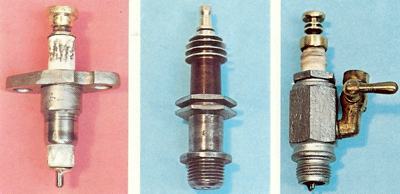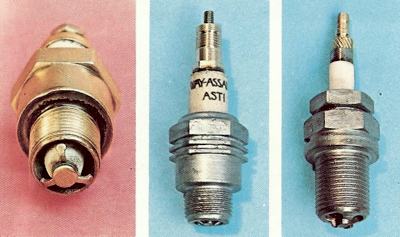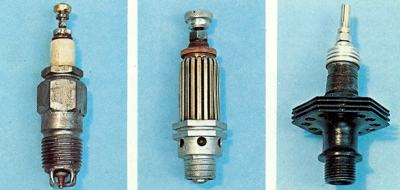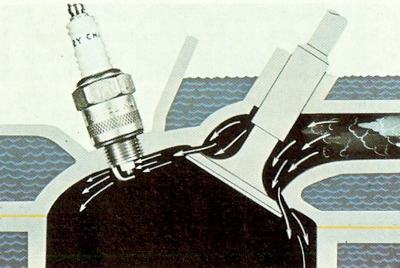The humble spark plug is made up from many materials – even precious metals such as gold and silver, platinum and iridium, although admittedly in very small quantities. The familiar white insulator material has been known by a variety of names, years ago Lodge christened theirs Corundite, KLG called theirs Sintox, but whatever it was called, it was merely sintered aluminium oxide.
Sintered alumina creates a material of surprising mechanical strength, excellent electrical insulation characteristics, brilliant heat resistance, and best of all suitability for mass production methods. All these properties are of great importance, as the spark plug leads an extremely hard life, enjoying very little attention and is expected to be sold at very low prices.
Most of us think of the spark plug as a simple device we screw into the wall of our engine's combustion chamber, and there it offers a gap across which a high-tension spark is provided to ignite the fuel mixture. In that respect we are correct, and the construction of the spark plug is fundamentally simple. There is a steel body which screws into the engine and has hexagon flats formed on it for spanners, and into the bore of this body is an insulating mass through the centre of which passes a metal electrode.
To the outer end of this electrode a suitable high-voltage pulse is brought by the high-tension lead from the engine's distributor; at the other end, where the electrode protrudes into the combustion chamber, it is kept company at a distance of 20 to 35 thousandths of an inch by an earthing electrode protruding from the metal body of the plug. The central electrode has an arduous task, and this is where the fancy metals often feature. Because heat resistance and electrical conductivity are necessary attributes, alloys of nickel are commonplace, sometimes sheathed in copper or fused silica for a better bond with the insulator material.
This bonding and sealing is important for a number of practical reasons, of which some are very simple and fundamental: a leak would be deleterious, looseness could be disastrous. Development for racing necessitated development of spark plugs able to endure severe heat, and to have points made of platinum alloy in which iridium or tungsten would also be present. Platinum being very costly, these points were made of thin wire welded into position; but early versions were known to loosen and fall out of the plug into the engine cylinder.
Heat Value
One of the more significant advances came in the use of Gold Palladium for two-stroke race engines, these relying upon a centre electrode material (Gold Palladium) a fine wire of this alloy, which has a gold content of about 50 per cent, being fixed to a stub of the nickel alloy. This special tip extended the heat range of the spark plug and made it less susceptible to fouling. Heat value is the most important factor determining the suitability of a plug for a given engine. The difference in operating temperatures between an engine doing a lot of idling - such as your very own daily driver - and a highly-tuned racing engine run at high loads and speeds for protracted periods, is considerable.
For your car, it is necessary for the plug to run fairly hot so that any deposits of oil or other contaminants will be burned away. If they are not, the oil will accumulate and turn to carbon, forming an encrustation over the walls of the insulator body around which the spark can track to earth without jumping its appointed gap, and therefore without igniting the compressed charge in the combustion chamber. At the other extreme, if a hot-running plug were fitted in a high-performance engine driven hard, its tip would soon become incandescent, causing pre-ignition that would probably wreck the engine - starting by burning a hole in s the
piston crown - before the plug itself failed.
Soft and Hard Plugs
Plugs that run cool are also known as 'hard' plugs, hot-running ones as 'soft'. It does not matter which terminology is employed, so long as the correct is principles are remembered: a soft plug for a soft engine, a cool plug for a hot engine, and vice versa. Clearly it is vital to use the type of plug specified by your cars manufacturer: it might be permissible to choose one grade softer when doing a lot of gentle driving (such as in urban traffic) if fouling and eventual misfiring is a problem, as it might be if the condition of the engine were such as to allow more than the usual amount of lubricating oil to get past
piston rings or valve guides into the combustion chamber.

Left: The first plug, made by Lenoir in 1860. Centre: A Bosch racing plug with mica insulator circa 1970. Right: A Champion plug with priming tap, circa 1910.

Left: SAGT with three brass electrodes. Centre: Way Assauto with twin electrodes, circa 1904. Right: RMV Spark Plug circa 1910.

Left: Champion spark plug circa 1901. Centre: Beru spark plug with brass segments, circa 1905. Right: Plug with cooling fins and mica insulator, circa 1967.

Some plugs have projecting electrodes, which are cooled by the incoming charge of petrol and air. |
If this course is adopted, care must be taken not to use full throttle for long, nor high revs at all. Conversely, if some very hard driving is anticipated, especially on freeways or tracks that allow high speeds and loads to be sustained for long periods, and most especially if the engine is suspected of running on a mixture slightly weaker than is correct, then a harder grade of plug would be recommended. Again, if the engine has been fitted with a capacitor discharge ignition system, a harder grade could be adopted because the characteristics of these systems include a very rapid voltage rise, encouraging the spark to jump the gap regardless of fouling conditions.
Unique Cars and Parts always stick with the manufacturer specifications, as we are not involved in motorsport.
Only inside the walls of the plug body can any significant difference be seen between a hard plug and a soft one. A cool hard plug has very little of its central electrode protruding from the tip of the insulator, and not much area of the insulator itself will be exposed to the heat of combustion, for the insulator will be seated in the metal body of the plug quite close to the nose. The object of this is to shorten the path whereby heat may escape from the plug tip to the body and thence, through the contact area of its threaded portion, to the material of the engine
cylinder head and thus away. A soft hot-running plug provides a longer path for the heat to travel: the insulator material leaves more of the central electrode exposed, and is seated high up in the plug body, from which it follows that it exposes more of its surface to combustion heat.
Deposits and Fouling
This greater exposure ensures that the tip remains hot, encouraging the immediate burning off of any potential deposits: even if they do not bum immediately, they have to extend over a greater surface before eventually creating an effective short circuit, or tracking path whereby the spark might be earthed, and thus fail. The formation of deposits on the plug tip is clearly a constant problem, as it is implicit in the nature of the
internal combustion engine that it should continually produce carbon so long as it is running. The art of spark plug design and selection is to ensure that the plug runs hot enough to burn up deposits, without running too hot.
The spark plug is very sensitive to carburation: if the mixture be too rich, the latent heat of evaporation of the excessive fuel will cause it to run cooler, leaving a tell-tale coating of black soot on the plug. An excessively weak mixture will conversely make it run hotter, in which case the usual signs of overheating are a bleached or pale brown colouration of the metal surfaces of the plug exposed to combustion. These and numerous other signs may be interpreted by a skilled and experienced eye to constitute a valuable means of engine fault diagnosis; but the art is by no means as simple as is commonly supposed, for the various additives present in fuels and oils sometimes play tricks with the deposition processes, creating a plug appearance that could be wrongly interpreted.
In the days of leaded fuel one of the deposits most easily recognisable were little beads of lead salts, which formed on the insulator in certain high-temperature conditions: these originated in the lead compounds added to petrol to suppress detonation or knock, and it was the introduction of these compounds (tetraethyl lead being the most famous) that forced the spark plug industry to develop its a different type of insulating material. Previously the best spark plug insulators were made of mica, which had superseded the simple porcelain of the earliest plugs; but mica could not stand the chemical attack of the lead compounds, and ceramics took its place.
For some years after this it remained the practice to make plug bodies in two parts that could be unscrewed for cleaning purposes. This practice was soon abandoned because the seating and sealing of the insulator, upon the washers which provide its only thermal contact with the plug body, could not be reliable. Modern sealed plugs can be cleaned by careful scraping with a thin-bladed knife, an unsatisfactory method, or by spark plug cleaners which may be car
battery-operated, and use vibrating glass beads as a cleaning medium. Unlike sand blasting, this cannot damage the plug, or leave abrasive particles inside.
Cleaning the Plugs
If a set of plugs needs to be cleaned more than once during its useful life, which is limited by the prudent to about 20,000 kilometres, either the plugs are the wrong grade for the engine, or the engine itself is at fault. There is still some useful cleaning that can be done: the outside of the plug, in particular the surface of the insulator body, must be kept clean by regular wiping (with a rag or tissue dampened with petrol or alcohol) lest accretions of dirt provide a tracking path whereby the spark can escape to earth from the top of the central electrode. The only other desirable maintenance is the checking and correct setting of the spark gap. This used to be as little as 0.018 inch in the old days of magnetos and inefficient coil ignition systems, but as engines became more refined (and thus had a higher compression) the gap was commonly 0.03 inch or even more.
Gauges are marketed with which the gap can conveniently be measured, but they are not always accurate: a pitted or bent electrode will offer a bigger gap than conventional gauges will indicate. Use of a round wire of known diameter is preferable, and with some of the less common types of earthing electrode such as the once-popular multiple-point, and the racing side-electrode, the wire is often easier to use. Variations in spark gap design are amongst the most notable, even notorious, of departures from spark plug convention. There have been numerous so-called 'fuel igniters' marketed in or by American manufacturers as early as the mid 1960's, all claiming better performance, greater economy and longer life, without needing any attention.
Surface Discharge Plugs
Some of the claims were undoubtedly excessive, but the working principle of these igniters is valid in certain circumstances. During the late 1970's these existed within the combustion chambers of the flat-12 Formula One Ferrari engine, and also in the Formula Two BMW motor sometimes employed by March; and for these applications the most reputable and responsible of American plug makers, Champion, developed what they more accurately described as surface discharge plugs. In these the fairly large-diameter tip of the central electrode was surrounded by a constant gap, the earthing electrode being a concentric ring or annulus, and the entire nose of the plug was given a flush surface because the gap was filled by a semi-conductor material.
The spark jumped across this surface from the central electrode to the annulus, usually taking the shortest route: as this caused microscopic erosion, the next spark moved to the next point on the annulus, so the effect was for the spark to travel round in circles. The erosion was barely more than theoretical, plugs of this type having an extremely long life. What was far more important was that they had a virtually infinite heat range, so fouling was not a problem. In fact the surface discharge plug did not really work properly until it was dirty! Nor did it work properly unless the spark pulse had the requisite characteristics, which again were supplied by a capacitor discharge system. Even that was not enough, as the plug annulus had to be in the right position relative to the combustion chamber, and engines that were not designed to use plugs of this type were seldom able to exploit them effectively.
In older cars, some engines, but by no means at all, may be well served by plugs of the extended-nose variety, in which the electrodes and the tip of the insulator protrude into the combustion chamber, relying on the high velocity draught of cool fresh mixture during each induction phase to carry away the excess of the heat absorbed during the previous combustion and
exhaust phases. Otherwise most of the constructional differences in modern plugs are invisible, consisting of spark-intensifying gaps in the central electrode, resistors, and other inclusions to improve ignition performance or suppress radio-frequency interference.
But the truth is, these days, plug construction is remarkably uniform and almost as standardised as
tyre valves: there are only three standard diameters for the threaded portion of the body (10, 14 and 18 mm), the smallest being welcomed for the space it saves, and the largest being enjoyed for its greater heat range, while the 14 mm plug is standard for most road-going cars. The length of the threaded portion also varies, and is a dimension that is too easily overlooked: a short-reach plug in a medium or long-reach hole will be too shrouded to work effectively, and is likely to become fouled rapidly.
Although some engines are designed so that the plug tip is deliberately shrouded - while a plug that is too long may either protrude into the combustion chamber and there overheat or even cause mechanical damage by contact with the
piston or valves, or alternatively if the head construction prevents this it will not be able to seat properly on its flange, in which case it will not be able to shed its heat properly nor be gas tight. This flange is usually flat, and seats on a sealing washer that should be replaced by a new one whenever the plug is removed; but some plugs, notably those employed by Vauxhall and certain other GM cars, have an angled seat which is stronger and provides a better heat path.



